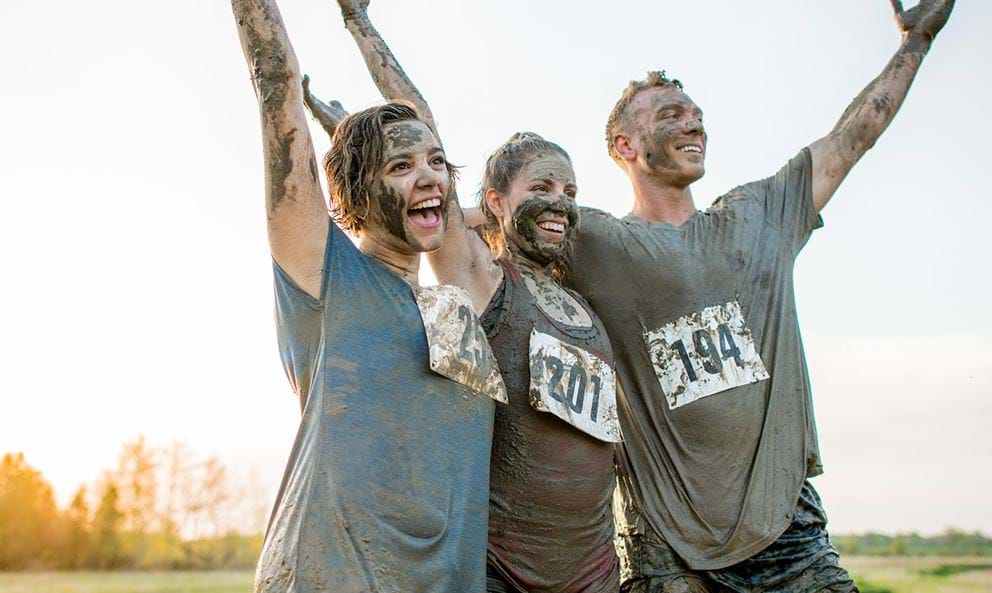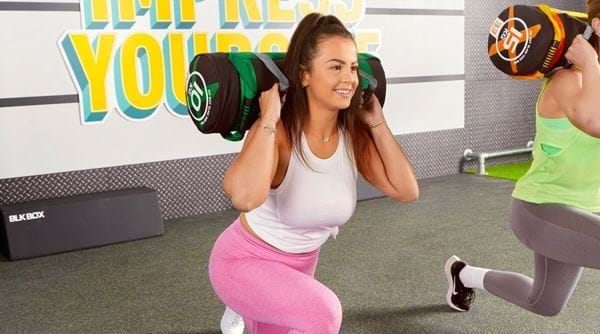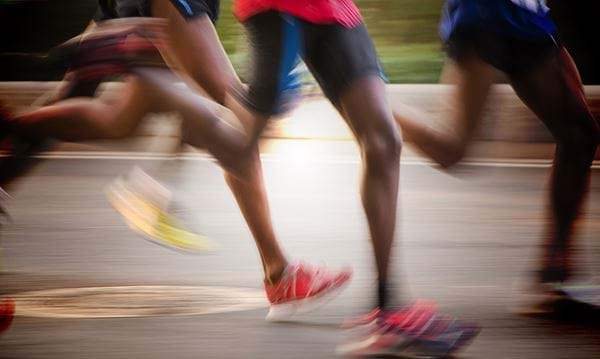Mud Run Challenge Training Plan and Tips

How To Train For Mud Run | Example Mud Run Training Plan
From Tough Mudder to Born Survivor and the Spartan Race, mud runs are more popular now than ever. Something about the blend of full-on workout and simulated boot camp torture just seems to strike a chord with a large number of fitness fanatics around the nation and, for that matter, the world.
If you've decided to give one of these events a go, you might be wondering how best to prepare for a mud race. After all, it's difficult to replicate the race conditions while training - unless your gym happens to have an area with barbed wire and pools of mud. Luckily there are a few gym-based alternatives to the real thing that will help you to get in shape in time for challenge day.
How To Train For A Mud Run Obstacle Course
1. Strength training
One of the great challenges in every mud run is having to climb over obstacles — often wooden walls — of different heights.
Strong muscles are essential for overcoming obstacles like climbing walls, carrying heavy objects, and navigating through mud pits. This means that strength training is a crucial training step for mud run preparation because it builds the foundation for your training. Exercises like squats, deadlifts, pull-ups, and push-ups target major muscle groups, improving overall strength and power. Plus, strength training helps reduce the risk of injuries by strengthening tendons, ligaments, and bones, meaning you can race more safely.
2. Cardiovascular exercise
Mud runs require a lot of strength but it’s still a run. All the exotic obstacles aside, you run a real risk of being thwarted by the most mundane part of the race — the running itself — if you don’t do the appropriate, traditional cardio required to prepare.
Cardiovascular exercise, such as running, cycling, and rowing, is essential for building endurance and improving cardiovascular health. Increasing your heart and lung efficiency will help you to maintain a steady pace throughout the race and recover quickly between obstacles. It also helps improve oxygen delivery to working muscles, delaying fatigue and improving overall performance.
3. Agility and functional training
Having to navigate through challenging terrain and obstacles is a large part of mud runs. Whether it's army crawling under a net, or swinging across a moat, your grip, mobility, coordination, and balance are going to be challenged.
Agility ladder drills, kettlebell swings, and agility-based exercises mimic the unpredictable movements encountered during a mud run, helping you to react quickly and maintain stability, while functional training can help to improve your movement patterns and coordination needed for climbing, crawling, swinging and lifting, improving overall athleticism and reducing the risk of injury during dynamic movements.
4. Core stability
Core stability is fundamental for maintaining proper posture, balance, and control during the varied movements of a mud run. When everything’s covered in slippery mud, you’ll appreciate the skill of being able to stay on your feet.
Core-focused exercises like Russian twists, hanging leg raises, and planks strengthen the muscles of the core, including the abdominals, obliques, and lower back. A strong core will keep you stable and help with power transfer and injury prevention, especially when navigating through uneven terrain, carrying heavy loads, or performing explosive movements.
5. Power and explosiveness
Many of the obstacles in mud run races require bursts of power and explosiveness to overcome. Training explosive movements like plyometric exercises such as box jumps, medicine ball slams, and jumping lunges, will develop your fast-twitch muscle fibres, improving your ability to generate force rapidly. These explosive movements translate to overcoming hurdles, leaping over obstacles, and accelerating out of muddy pits, all while keeping your energy levels as high as possible. Incorporating power exercises into your training regimen enhances overall athleticism, agility, energy and race performance.
Active recovery and rest
Active recovery and rest days are essential components of any training program to allow your body to recover and adapt to the physical demands of training. Adequate rest prevents overtraining, reduces the risk of injury, and promotes muscle repair and growth. Activities like light stretching, foam rolling, and low-intensity exercise improve circulation, alleviate muscle soreness, and enhance recovery between intense training sessions. Prioritising rest and recovery ensures that you're fully prepared and energised for your mud run event.
The Best Mud Run Training Plan For The Gym
Here’s a mud run workout plan that’s designed to get you fit and ready for your event. We’ve given some examples of sets and reps, but listen to your body to see if these suit you - you want to feel challenged without being completely exhausted.
Day 1: Strength and power
Warm-up: 5-10 minutes of light cardio (jogging, cycling, or rowing)
- Squats: 4 sets x 8-10 reps
- Deadlifts: 4 sets x 8-10 reps
- Box Jumps: 3 sets x 10 reps
- Medicine Ball Slams: 3 sets x 12 reps
- Pull-ups or Lat Pulldowns: 3 sets x 8-10 reps
- Push-ups: 3 sets x max reps (or modified push-ups if needed)
- Plank: 3 sets x 30-60 seconds
Day 2: Cardio and endurance
Warm-up: 5-10 minutes of light cardio
- Treadmill Sprints: 10 rounds of 30 seconds sprinting, 60 seconds walking or jogging
- Rowing Machine: 5 minutes at moderate intensity
- Battle Ropes: 3 sets x 30 seconds
- Burpees: 3 sets x 15 reps
- Cycling: 15 minutes at a moderate pace
- Jump Rope: 3 sets x 1 minute
Day 3: Active recovery or rest
- Light stretching or yoga
- Foam rolling for muscle recovery
- Light walking or cycling for 20-30 minutes
Day 4: Agility and Core
Warm-up: 5-10 minutes of light cardio
- Agility Ladder Drills: 3 sets x 30 seconds
- Kettlebell Swings: 4 sets x 12 reps
- Russian Twists: 3 sets x 15 reps each side
- Toe Touches: 3 sets x 10 reps
- Farmer's Walk: 3 sets x 50 feet
- Side Plank: 3 sets x 30 seconds each side
Day 5: Functional strength and endurance
Warm-up: 5-10 minutes of light cardio
- Ball slams: 4 sets x 8-10 reps
- Sled Push or Pull: 4 sets x 50 feet
- Sandbag Carry: 3 sets x 100 feet
- Wall Climbs: 3 sets x 5 reps
- Mountain Climbers: 3 sets x 30 seconds
- Jumping Lunges: 3 sets x 12 reps each leg
Day 6: Long distance run
Run or jog for a distance of 5-10k at a moderate pace. Focus on building endurance and mental toughness.
Day 7: Rest
Complete rest or light activity such as walking or gentle stretching.
For more inspiration for your pre-mud run training, check out our other workout plans, like this running and strength training plan, this beginner's gym machine workout routine or this gym cardio workout plan. Getting prepped couldn’t be easier than with a PureGym membership - we have 340+ gyms across the UK with top-of-the-range fitness equipment to help you on your muscle-gaining journey. You can even book an appointment with one of our expert personal trainers - they’ll be able to give you all the advice and guidance you need to get strong.


